Microsoft AZ-801 Exam Practice Questions (P. 5)
- Full Access (282 questions)
- One Year of Premium Access
- Access to one million comments
- Seamless ChatGPT Integration
- Ability to download PDF files
- Anki Flashcard files for revision
- No Captcha & No AdSense
- Advanced Exam Configuration
Question #21
HOTSPOT -
Your network contains an Active Directory Domain Services (AD DS) domain. The domain contains servers that run Windows Server as shown in the following table.
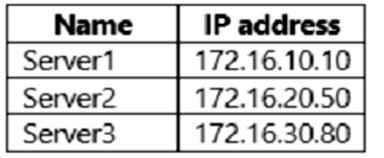
Server1 has the connection security rules shown in the following table.

Server2 has the connection security rules shown in the following table.

For each of the following statements, select Yes if the statement is true. Otherwise, select No.
NOTE: Each correct selection is worth one point.
Hot Area:
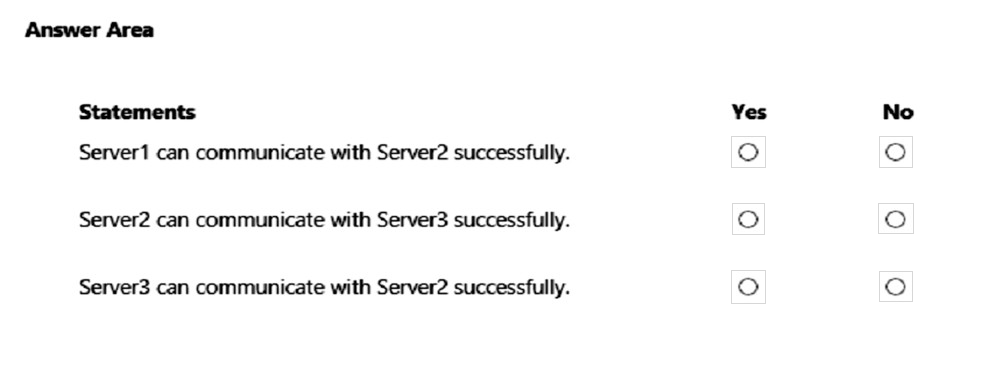
Your network contains an Active Directory Domain Services (AD DS) domain. The domain contains servers that run Windows Server as shown in the following table.

Server1 has the connection security rules shown in the following table.

Server2 has the connection security rules shown in the following table.

For each of the following statements, select Yes if the statement is true. Otherwise, select No.
NOTE: Each correct selection is worth one point.
Hot Area:

Correct Answer:
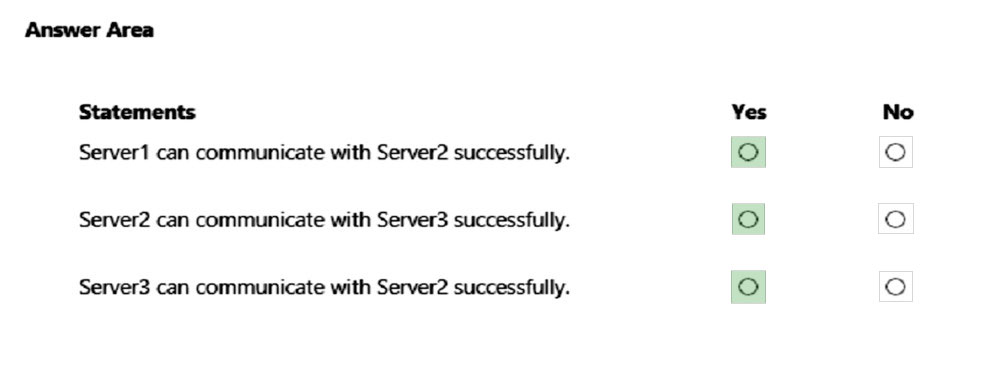
Reference:
https://docs.microsoft.com/en-us/windows/security/threat-protection/windows-firewall/change-rules-from-request-to-require-mode

Reference:
https://docs.microsoft.com/en-us/windows/security/threat-protection/windows-firewall/change-rules-from-request-to-require-mode
send
light_mode
delete
Question #22
Note: This question is part of a series of questions that present the same scenario. Each question in the series contains a unique solution that might meet the stated goals. Some question sets might have more than one correct solution, while others might not have a correct solution.
After you answer a question in this section, you will NOT be able to return to it. As a result, these questions will not appear in the review screen.
You have a failover cluster named Cluster1 that hosts an application named App1.
The General tab in App1 Properties is shown in the General exhibit. (Click the General tab.)
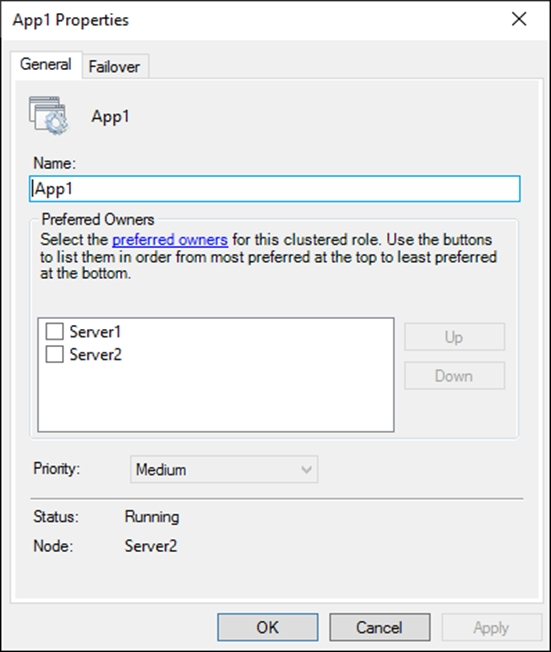
The Failover tab in App1 Properties is shown in the Failover exhibit. (Click the Failover tab.)
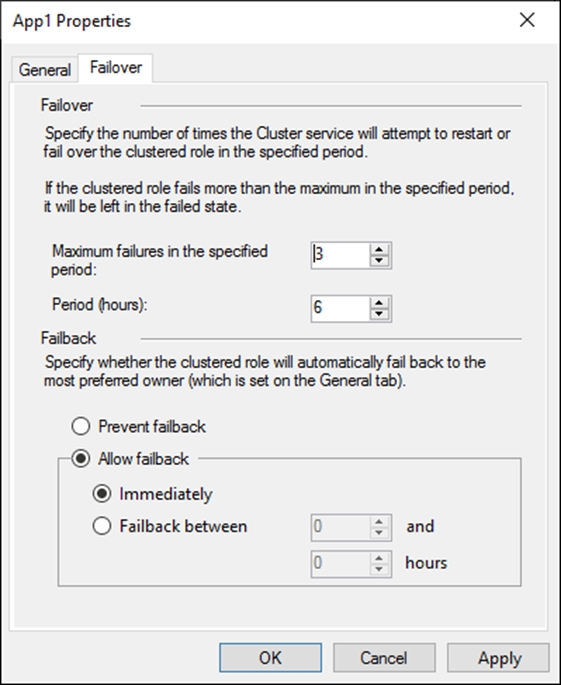
Server1 shuts down unexpectedly.
You need to ensure that when you start Server1, App1 continues to run on Server2.
Solution: From the Failover settings, you select Prevent failback.
Does this meet the goal?
After you answer a question in this section, you will NOT be able to return to it. As a result, these questions will not appear in the review screen.
You have a failover cluster named Cluster1 that hosts an application named App1.
The General tab in App1 Properties is shown in the General exhibit. (Click the General tab.)

The Failover tab in App1 Properties is shown in the Failover exhibit. (Click the Failover tab.)

Server1 shuts down unexpectedly.
You need to ensure that when you start Server1, App1 continues to run on Server2.
Solution: From the Failover settings, you select Prevent failback.
Does this meet the goal?
- AYesMost Voted
- BNo
Correct Answer:
A
The Prevent failback setting will prevent the cluster failing back to Server1.
A
The Prevent failback setting will prevent the cluster failing back to Server1.
send
light_mode
delete
Question #23
Note: This question is part of a series of questions that present the same scenario. Each question in the series contains a unique solution that might meet the stated goals. Some question sets might have more than one correct solution, while others might not have a correct solution.
After you answer a question in this section, you will NOT be able to return to it. As a result, these questions will not appear in the review screen.
You have a failover cluster named Cluster1 that hosts an application named App1.
The General tab in App1 Properties is shown in the General exhibit. (Click the General tab.)
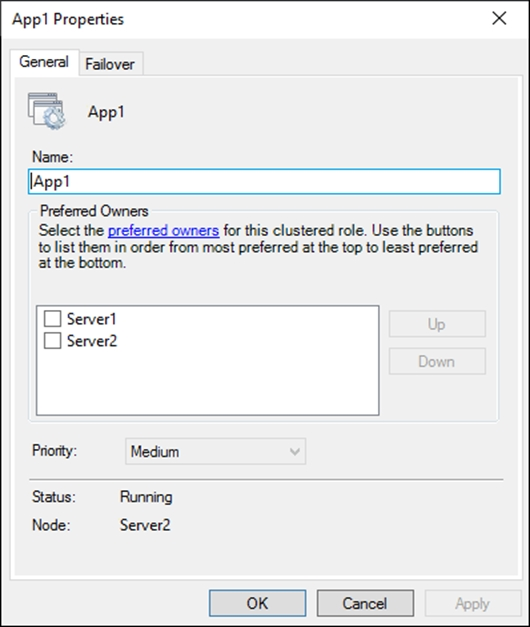
The Failover tab in App1 Properties is shown in the Failover exhibit. (Click the Failover tab.)
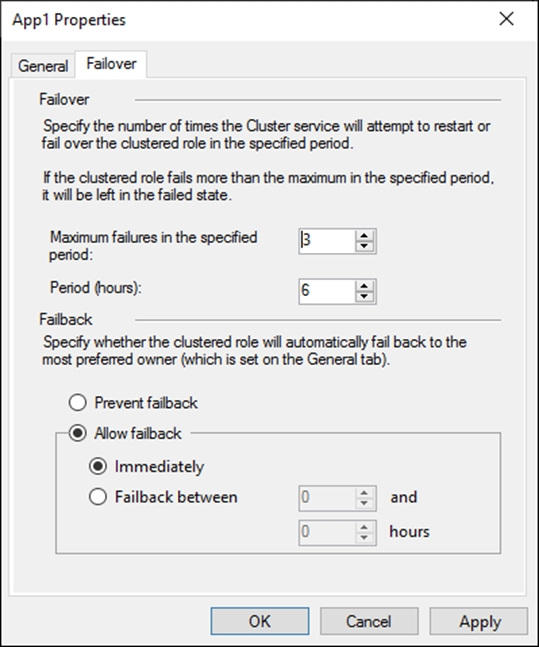
Server1 shuts down unexpectedly.
You need to ensure that when you start Server1, App1 continues to run on Server2.
Solution: You increase Maximum failures in the specified period for the App1 cluster role.
Does this meet the goal?
After you answer a question in this section, you will NOT be able to return to it. As a result, these questions will not appear in the review screen.
You have a failover cluster named Cluster1 that hosts an application named App1.
The General tab in App1 Properties is shown in the General exhibit. (Click the General tab.)

The Failover tab in App1 Properties is shown in the Failover exhibit. (Click the Failover tab.)

Server1 shuts down unexpectedly.
You need to ensure that when you start Server1, App1 continues to run on Server2.
Solution: You increase Maximum failures in the specified period for the App1 cluster role.
Does this meet the goal?
- AYes
- BNoMost Voted
Correct Answer:
B
The Maximum failures setting is used to determine when the cluster determines that a node is offline. It does not affect whether a cluster will fail back when a node comes online.
B
The Maximum failures setting is used to determine when the cluster determines that a node is offline. It does not affect whether a cluster will fail back when a node comes online.
send
light_mode
delete
Question #24
Note: This question is part of a series of questions that present the same scenario. Each question in the series contains a unique solution that might meet the stated goals. Some question sets might have more than one correct solution, while others might not have a correct solution.
After you answer a question in this section, you will NOT be able to return to it. As a result, these questions will not appear in the review screen.
You have a failover cluster named Cluster1 that hosts an application named App1.
The General tab in App1 Properties is shown in the General exhibit. (Click the General tab.)
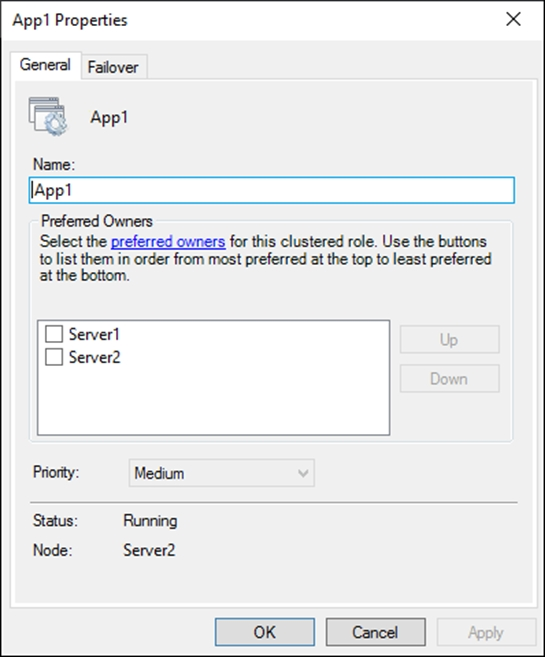
The Failover tab in App1 Properties is shown in the Failover exhibit. (Click the Failover tab.)
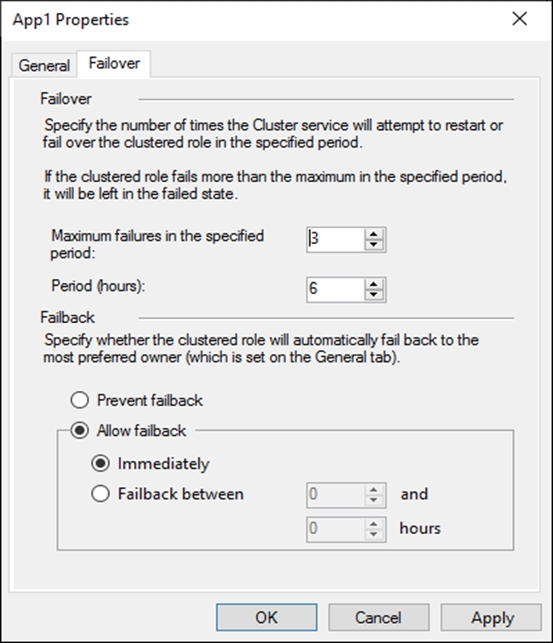
Server1 shuts down unexpectedly.
You need to ensure that when you start Server1, App1 continues to run on Server2.
Solution: From the General settings, you move Server2 up.
Does this meet the goal?
After you answer a question in this section, you will NOT be able to return to it. As a result, these questions will not appear in the review screen.
You have a failover cluster named Cluster1 that hosts an application named App1.
The General tab in App1 Properties is shown in the General exhibit. (Click the General tab.)

The Failover tab in App1 Properties is shown in the Failover exhibit. (Click the Failover tab.)

Server1 shuts down unexpectedly.
You need to ensure that when you start Server1, App1 continues to run on Server2.
Solution: From the General settings, you move Server2 up.
Does this meet the goal?
send
light_mode
delete
Question #25
You have a failover cluster named Cluster1 that has the following configurations:
✑ Number of nodes: 6
✑ Quorum: Dynamic quorum
✑ Witness: File share, Dynamic witness
What is the maximum number of nodes that can fail simultaneously while maintaining quorum?
✑ Number of nodes: 6
✑ Quorum: Dynamic quorum
✑ Witness: File share, Dynamic witness
What is the maximum number of nodes that can fail simultaneously while maintaining quorum?
- A1
- B2
- C3Most Voted
- D4
- E5
Correct Answer:
C
Note this question is asking about nodes failing 'simultaneously', not nodes failing one after the other.
With six nodes and one witness, there are seven votes. To maintain quorum there needs to be four votes available (four votes is the majority of seven). This means that a minimum of three nodes plus the witness need to remain online for the cluster to function. Therefore, the maximum number of simultaneous failures is three.
Reference:
https://docs.microsoft.com/en-us/windows-server/storage/storage-spaces/understand-quorum
C
Note this question is asking about nodes failing 'simultaneously', not nodes failing one after the other.
With six nodes and one witness, there are seven votes. To maintain quorum there needs to be four votes available (four votes is the majority of seven). This means that a minimum of three nodes plus the witness need to remain online for the cluster to function. Therefore, the maximum number of simultaneous failures is three.
Reference:
https://docs.microsoft.com/en-us/windows-server/storage/storage-spaces/understand-quorum
send
light_mode
delete
All Pages
